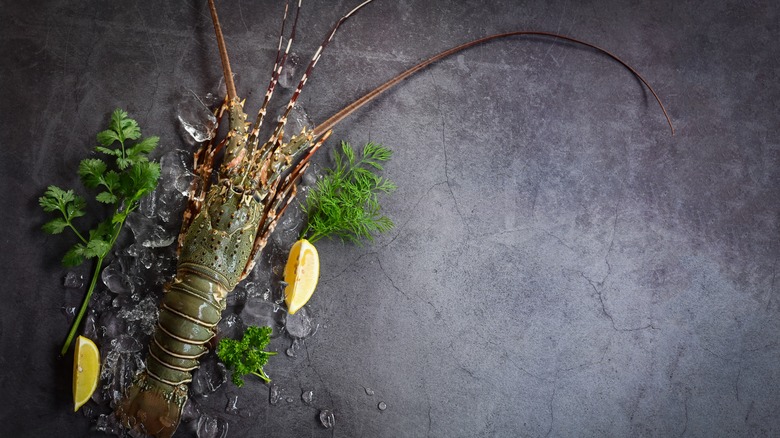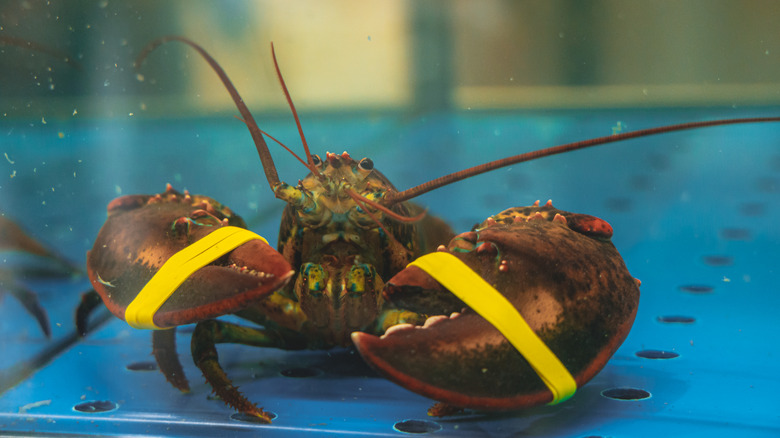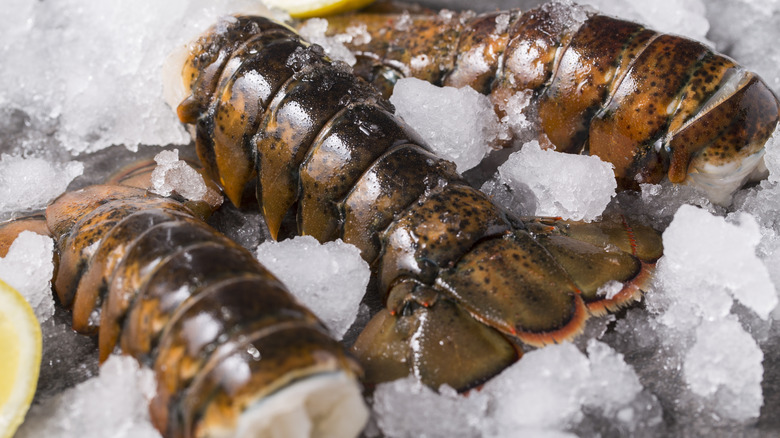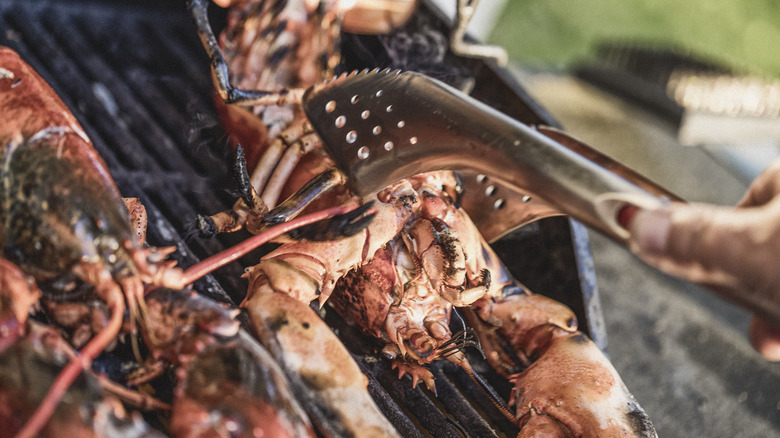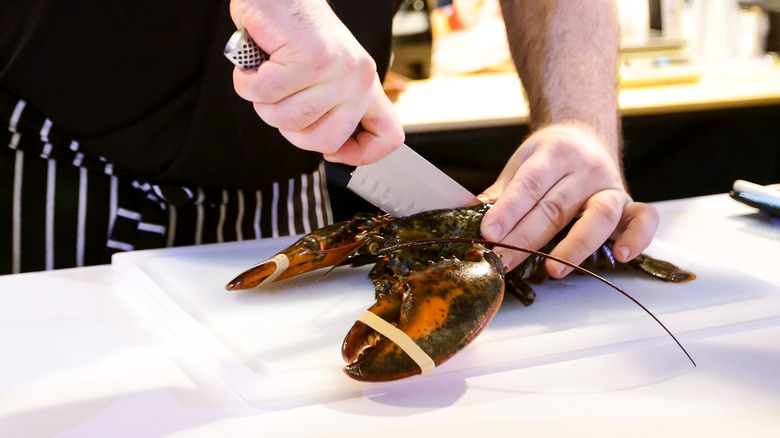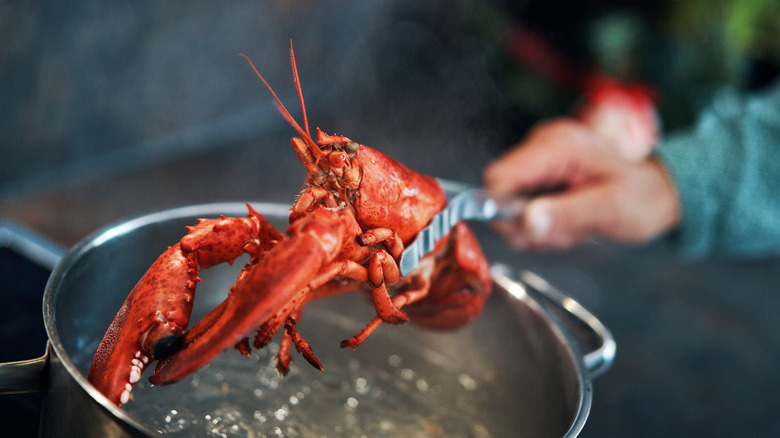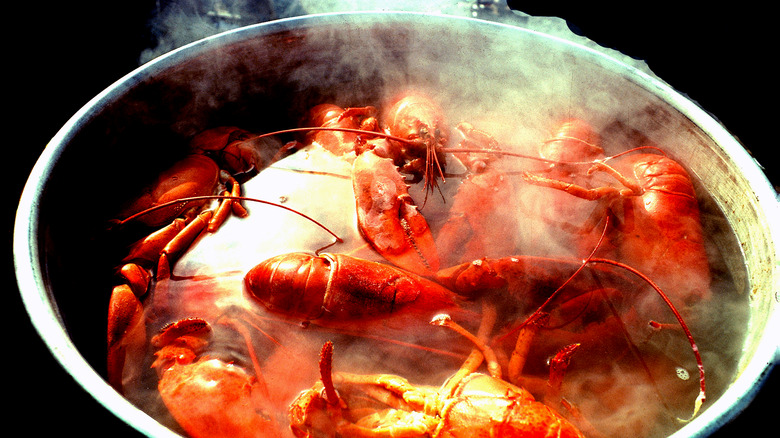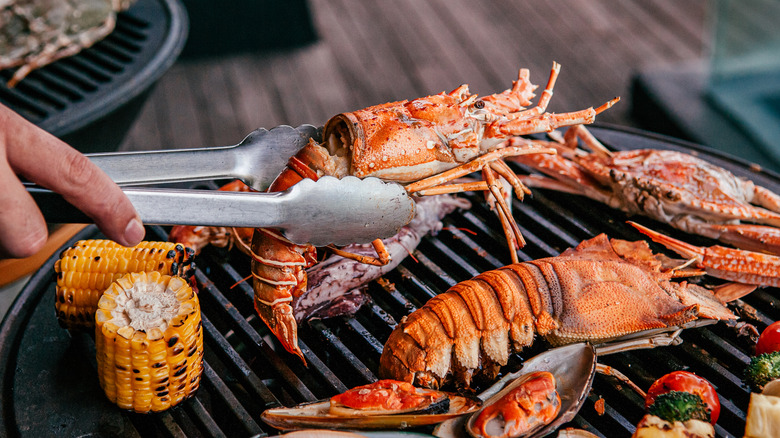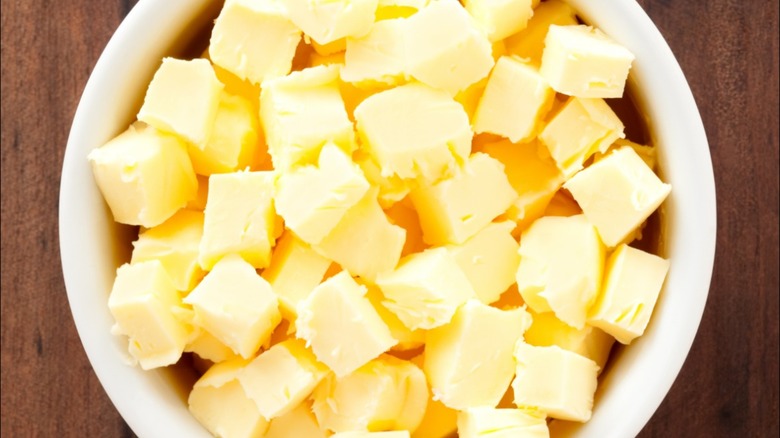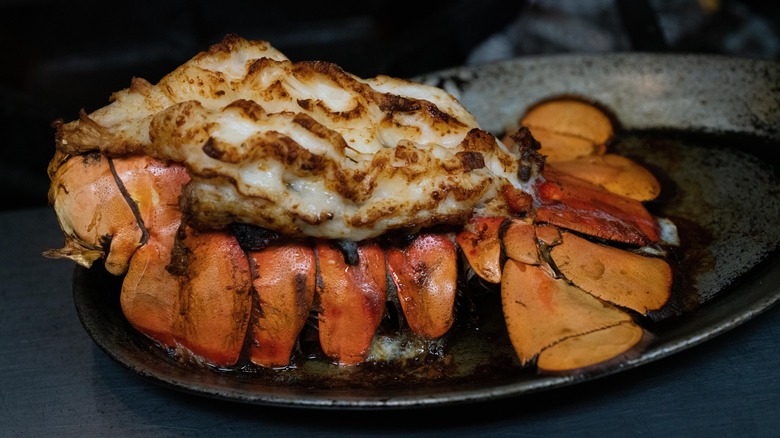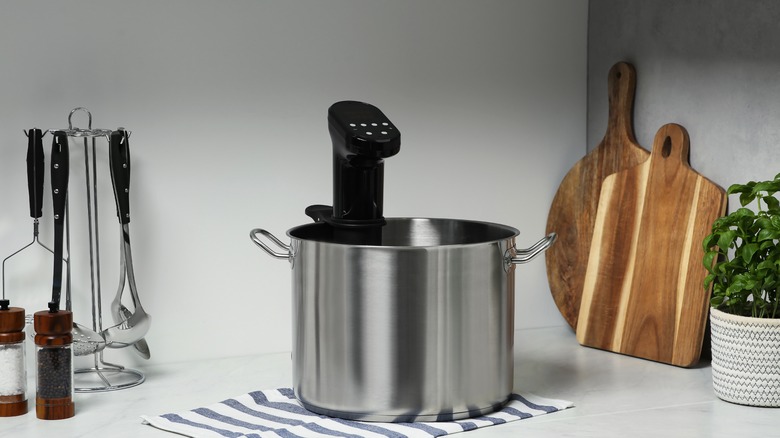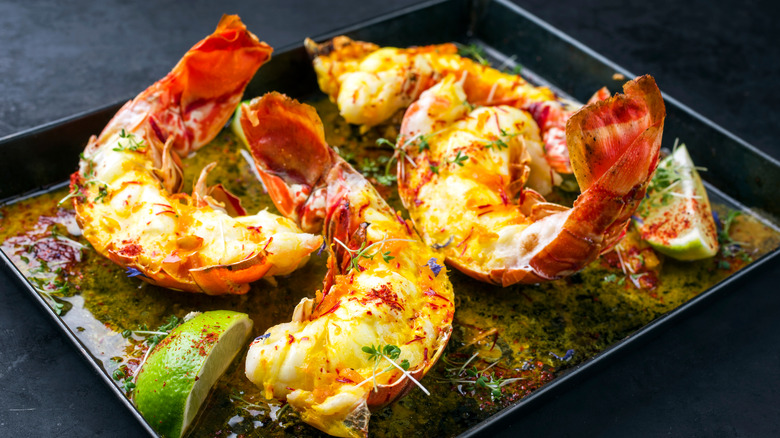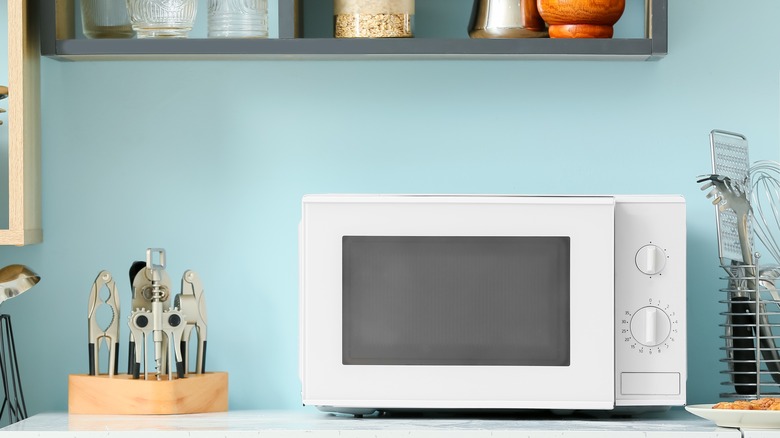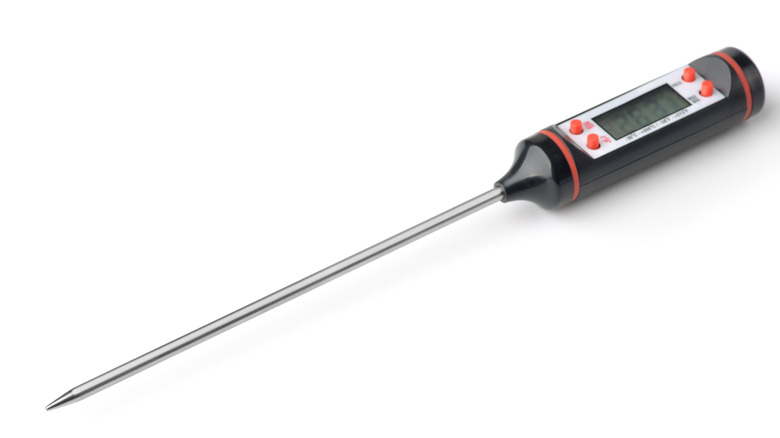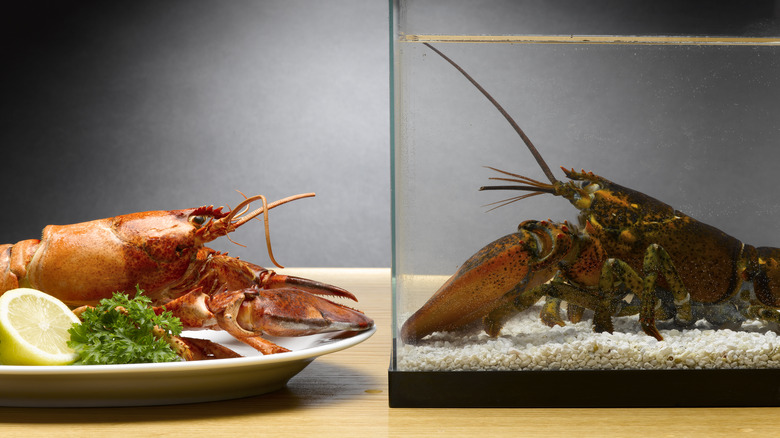How To Buy And Cook A Live Lobster: Steaming, Boiling And Roasting
Lobster hasn't always had such an elevated status as a luxury food item in the culinary world. When European settlers first set foot in North America, these crustaceans washed ashore to form piles up to two feet high. They were so plentiful that hungry people could pluck them from the shore — no boat or trap needed. This abundance made them cheap, the perfect protein for people with less money, including workers and enslaved people. Some workers-for-hire were so tired of eating lobster that they added clauses into employment contracts stating that lobster could only be served a limited number of times per week.
In the 1880s, diners in big East Coast cities began to elevate this crustacean into fine-dining status, increasing the price accordingly. As a delicacy during World II, lobsters were not rationed, so those who could afford it with their wartime economic spoils ate lobster as much as their wallets could afford.
These days, lobsters no longer come crawling onto the dinner plate in such numbers, and harvesting is tightly regulated. In a roll at the beach or delivered as part of a special occasion dinner, lobster is an event no matter how you eat it. But proper preparation is critical. Here's what you need to know about the best cooking methods for lobster.
How to shop for lobster
Shopping for lobster starts with deciding if you'd like fresh or frozen lobster. Although frozen lobster is convenient and makes it easy to plan ahead, the best choice for any application is nearly always fresh.
Your fishmonger may have many different types of lobster to choose from. The most common types in North America are Maine lobsters and spiny lobsters. Maine lobsters are larger and have meat throughout their body, while the smaller spiny lobster is most often harvested for the tail only. For Maine lobsters, look for specimens that are between 1-2 pounds.
Regardless of the type, fresh lobster should be active and moving, with a blueish-green or brown color. Lift up the lobster — healthy lobsters should curl their tails automatically underneath their body, while old or nearly dead ones have limp, lifeless tails. While you're holding it, smell the lobster. It should smell fresh and briny, like the sea (not like ammonia). When buying tails only, the shell should be hard and not slimy.
Female lobsters come with a bonus ingredient: lobster roe. If you want to intentionally seek out females, look for the slightly broader and softer flippers that indicate a female lobster.
The best place to purchase lobster is fresh off the boat, but not everyone has that access. When grocery shopping, check the source. Many lobsters come with sustainability certifications from the Marine Stewardship Council (MSC), but those that don't should still be harvested from a reputable fishery.
How to store lobster
The method of storage depends on whether the lobster is live, frozen, or pre-cooked. You'll also store lobster differently depending on when you plan on cooking it. For a live whole lobster, place it in a cardboard box and cover it with seaweed or a wet newspaper. Store it in the coldest part of your fridge and prepare it within a day of buying.
Waiting more than a day to cook a whole, live lobster? It's best to avoid getting a live lobster. Their quality (and their quality of life) suffers from extended storage. Getting a frozen lobster is better if you don't cook it immediately. Raw lobster tails or lobster meat should also be stored in the coldest part of your fridge. The best setup is on a bed of ice in a pan with drainage holes. This keeps them fresh for up to two days.
If you won't use the raw tail or meat within 48 hours, your best bet is the freezer. Wrap them tightly in plastic wrap and aluminum foil, then place them in heavy-duty freezer bags or airtight containers to prevent freezer burn. You can store lobsters this way for up to six months, but their quality will degrade over time. Never store lobster in fresh water, and don't seal a live lobster in a bag. This will kill them and render them unusable.
How to prepare lobster
No matter the method of preparation, you'll need sturdy tongs that can handle the heat of the stove or grill. A timer, sharp knife, kitchen shears, and gloves for handling spiny lobster are also helpful.
Traditionalists use a large pot to boil or steam. The ideal pot size for cooking lobster for two is at least 8 quarts. A steaming rack that fits inside the pot is necessary for steamed lobster, but it is possible to work around that by balling up aluminum foil and setting it in the pot. This holds the lobster above the boiling water. If you are baking, roasting, or broiling your lobster, you need a large, oven-safe pan to hold them. Sous vide lobster uses a vacuum sealer plus bags to contain the lobster. An immersion circulator sits in a large pot and maintains a set temperature to cook the lobster evenly.
In addition to a large cooking pot, you'll also need a large pot to hold ice water. An ice bath stops the cooking process — this is necessary for cold lobster salads or other preparations where the lobster will not be served whole. Butter poaching a lobster requires a saucepan that can hold both heat and lobsters. A spoon or basting brush is also helpful. Basting brushes are used when grilling or preparing lobster in the oven.
How to pick the best method for cooking lobsters
Before cooking, take care to dispatch your live lobster humanely. Place it in the freezer for 30 minutes before cooking, then plunge a very sharp knife swiftly between its eyes, straight down through its body. If you are cooking a whole lobster, keep the tail from curling during cooking by inserting a skewer just below the tail's shell.
Your cooking method often depends on how you'll use the lobster once it's cooked. Boiling is the fastest method to cook whole lobster, but it requires careful attention to prevent it from becoming tough and rubbery. Both steaming and boiling are good options for whole lobster, but unless you add something to the water when boiling, there's not a ton of flavor (other than the lobster itself).
Butter poaching lobster is perfect for dishes such as lobster thermidor or a lobster roll, and sous vide lobster works well if you are planning on creating a delicious lobster bisque. If you are a skilled grillmaster and ready to try your hand at lobster, grilling (tails only or the entire lobster) imparts a smoky flavor that is hard to beat. You can also baste your lobster as it grills with any type of seasoned butter. Pick out the meat and eat it as-is, or add it to a lobster roll or cold lobster salad.
How to boil lobster
A seafood boil in the Northeast isn't complete without lobster. It's an easy, if slightly finicky, process that requires only sensitivity to timing.
Use a large pot of salted water (8 quarts for two lobsters is a good size). Add water and salt; a good guideline for salt is to make the water the same brininess as the sea from which your lobster came. If you've put your lobster in the freezer, remove it and dispatch it humanely right before you plunge it headfirst into the boiling water. Use tongs, and be careful of splashing. A 1-pound lobster takes between 8 and 10 minutes to cook. Add another three minutes for each additional pound.
Worried your boiled lobster will taste plain? Take a tip from Martha Stewart and add some vodka or tequila to the water. This imparts another layer of savory flavor with no alcohol residue.
How to steam lobster
Steaming lobster takes a little more time than boiling, but if you're looking for a preparation that highlights the natural sweetness and mild buttery texture of the crustacean, this one's for you. You'll use the same pot you would use for steaming but with a few added tools.
Add two inches of salted water to the pot and bring to a boil. At this point, you can place a steaming rack in the pot if you have one. You can also DIY one by crumbling up large balls of aluminum foil that will keep the lobster out of the boiling water.
Cover the pot and steam at 8 minutes per pound (and another 3 for each additional pound). It can be tempting to check on the progress of your lobster but resist the urge. Every time you lift the lid for a peek, you release the steam necessary to complete the cooking process. This extends your cooking time and can result in tough, overcooked lobster.
It is possible to add flavor to steamed lobsters as they cook. Add peppercorns, bay leaves, lemon slices, or fresh herbs to bathe your lobster in a flavorful steam bath.
How to grill lobsters
Grilling lobster gives it an exceptionally smoky flavor that's a contrast to the sweet, briny flavor of the sea. The heat of the grill caramelizes the surface of the lobster for a nice textural contrast. But many people struggle to master grilling any type of seafood. In the quest for the perfect marks, it's easy to overcook lobster on the grill. Careful preparation and attention to the grill temperature are important here. Start by preheating your grill to medium-high heat.
Whole lobster can be prepared on the grill, but it's more common to split the lobster (or just grill the tail). Once split, season the lobster. Melt butter and add salt and pepper, plus any other seasoning blends, herbs, and spices you like. Brush the lobster generously with this mixture.
Place both halves of the split lobster face down on the preheated grill and close the lid. This provides a nice sear and gets caramelization started. Grill for about 4 minutes, then open the lid and flip the lobsters. Brush more butter and seasoning on the lobster and grill for another 4-5 minutes or until they are done.
If you want to get very chef-y, follow Geoffrey Zakarian's lobster grilling method and poach your lobster before grilling. This method completes most of the cooking in two poaching liquids before kissing the lobster with smoke from the grill in the final step.
How to butter poach lobsters
Butter poaching lobster is a gentle way to capitalize on the silky smooth feel of delicate lobster meat. You can use whole lobsters or only the tails. Using lobster tail is easier, but if you choose to poach whole lobsters, you'll need to steam or boil them for 3-4 minutes first. Remove them from the pot, and immediately submerge them in ice water to stop the cooking. This makes it easier to remove the partially cooked meat from the shell. If you choose to use tails, it's easy to cut the underside of the tail shell with scissors and peel the meat out. You will need to remove the vein in the tail either way.
In a saucepan, add enough butter to cover the lobster meat. How much butter you need depends on how much lobster you're cooking. Reduce the chance of burning your butter as you poach by using ghee. Ghee is also known as clarified butter (for its clear, golden hue), and it is missing milk solids that can otherwise burn.
Melt the butter over low heat, taking care not to let it bubble or boil. Add the lobster meat, and maintain the temperature below a simmer (between 180 and 190 F). Poach at this temperature for 5-7 minutes. The timing varies depending on the size of your lobster pieces.
How to bake lobster
Baked lobsters are an easy preparation that doesn't suffer if you need to use frozen lobster. If it is frozen, thaw it before baking. Preheat your oven to 400 F and get a baking tray ready.
You will need to briefly steam or boil your lobster to humanely end its life before you prepare it for baking. Split a whole lobster as you did for poaching. Clean out any roe or intestinal gunk (tomalley). Brush the lobster with seasoned butter, and place each half open side down on the baking tray.
Bake the lobster for about 20 minutes. If you want to add stuffing or finish it with more seasoned butter, flip and stuff or baste, then return to the oven for another five minutes or so. If you've stuffed your lobster, finish it under the broiler for a caramelized, crunchy filling. Test for doneness, and don't be fooled by a lovely crust on any stuffing you use. Make sure the thermometer is testing the temperature of the lobster itself, not the filling.
Take care to monitor your lobster while it's baking. Lobster overcooks in the oven easily, and the smaller the lobster, the faster this can happen.
How to sous vide lobster
If you're an inexperienced cook who wants something as close to guaranteed perfection as you can get, sous vide lobster might be just for you. Sous vide cooking uses vacuum-sealed food submerged in a temperature-controlled water bath to produce food that is nearly impossible to overcook. If your water temperature is set to 135 F, the contents of the sealed bag will never get warmer than that.
These days, you don't need a spendy sous vide setup, either. Immersion circulators clamp on the side of your lobster pot to maintain the water temperature you need for perfect doneness. Clean and prepare your lobster for cooking (split whole lobster or tails), then vacuum seal it in a bag. You can add butter and other seasonings to the bag before sealing. These will gently infuse into the lobster as it cooks.
Follow your manufacturer's directions to set the appropriate temperature. Once the water reaches that temperature, set a timer. Most lobsters take between 30 and 40 minutes. When the lobster is cooked, cut open the bag and reserve the juices. If you want some color on your lobster, sear it briefly in a hot pan before drizzling with the reserved juices and serving.
How to cook lobster tails
If getting grubby to your elbows in lobster juice and guts doesn't sound like fun, you might be more inclined to try your hand at cooking a lobster tail. Lobster tails are easy to eat, satisfyingly meaty, and fun to prepare, with less cleaning and elemental goo to deal with than the full body. They can be boiled, steamed, grilled, baked, and cooked in an immersion circulator, too, with only a few slight adjustments.
There is no need for any additional preparation for boiling or steaming a lobster tail, but many people like to butterfly the tail when grilling or baking. To butterfly a lobster tail, cut from the top of the lobster tail to the base of the tail fin. Gently pry the shell open slightly, brush with seasoned butter or stuff, then proceed to bake or grill.
Lobster tails can also be butter-poached or pan-seared. Remove the tail meat and clean the vein for both preparations. When butter poaching, melt butter in a saucepan and proceed as above.
If you pan-sear, your lobster tail will be cooked through in less than five minutes. Heat a pan over medium heat and add clarified butter. Add the lobster and sear until it is cooked through. Pay close attention using this method, as the meat can go from perfection to a rubbery mess in seconds.
Can you cook lobster in a microwave?
The short answer is yes, but the long answer is a subject of much debate among chefs, many of whom use microwaves only for heating up leftovers and making bagged popcorn.
One major exception is Rich Vellante, executive chef of New England-based Legal Sea Foods. He believes that microwaving your lobster is not only okay but also the best way to cook a lobster. Microwaves steam a lobster in its own delicious juice from the inside out. This makes for a lobster that tastes wonderfully only of itself.
But there are caveats. It's very easy to overcook a lobster in a microwave, so don't hit the power button and walk away. And it's extra important to make sure that you have humanely processed the lobster before you cook it in the microwave. Once your lobster is safely dispatched, place it on a microwave-safe plate and dress it with a little lemon juice and water. Then, microwave on high for about 7 minutes for a 1-pound lobster.
How to know when lobster is fully cooked
Yes, a cooked lobster loses its muted green or blueish tones in favor of a screaming orange-red hue, but that doesn't mean it's totally cooked. For a foolproof method of testing for doneness, you'll need to check the temperature of your lobster, much like you do for a steak. Insert a quick-read digital thermometer into the thickest part of the lobster (the base of its tail). It is properly cooked when that temperature is between 135 F to 140 F.
In addition, the color of the meat changes when it's cooked. Raw lobster meat is translucent, almost see-through if you slice it thin enough. Once cooked, the meat becomes snowy white and opaque. To check, twist the tail off of the body to see if it is white. If not, add it back to the steamer, the grill, or the poaching liquid for another few minutes.
Some cooks rely on carryover cooking to finish their lobster. While it's true that a lobster may continue to cook for a few minutes after it's removed from the heat, this can be a dangerous gamble. It is possible to get sick from undercooked seafood. Cook the lobster all the way, then plunge it into ice water if you need the cooking to stop.
Lobster cooking mistakes
If you're new to cooking lobster, chances are good you're going to make some mistakes. Some of these mistakes will affect the taste, while others can make you very sick.
It all starts by making sure your lobsters are absolutely fresh and thriving before you cook them. If you have any questions about them, talk to a reputable fishmonger and only purchase lobster from a reliable source. Remember, too, that bigger is not better when it comes to lobster. Smaller lobsters tend to be more tender than larger ones.
Other common lobster cooking mistakes deal with either undercooking or overcooking your lobster. The former can cause illness, while the latter is merely unpleasant to eat.
But perhaps the biggest lobster cooking mistake you can make? Throwing out your lobster shells. Many newbies to cooking crustaceans automatically discard their spent lobster shells when dinner time is over. But these shells can be used to make an incredibly flavorful seafood stock. If you don't feel like hauling out the stockpot right away, pop the shells in the freezer until you're ready.
